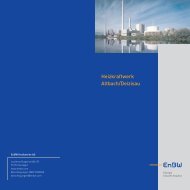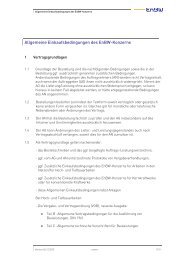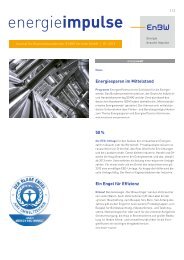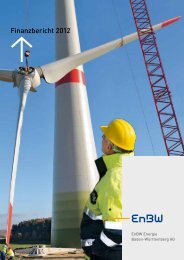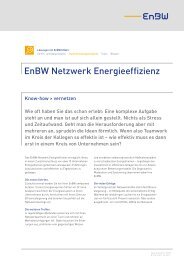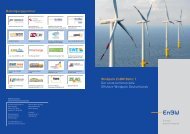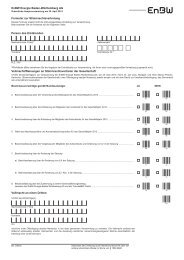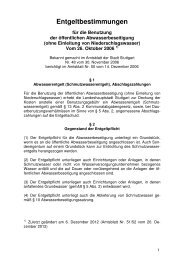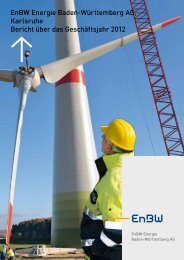Environmental Report 2000 - EnBW
Environmental Report 2000 - EnBW
Environmental Report 2000 - EnBW
Create successful ePaper yourself
Turn your PDF publications into a flip-book with our unique Google optimized e-Paper software.
Special Topics<br />
Special Topics<br />
Our position as an innovative company on the European energy market is consolidated<br />
through our activities in research, development and demonstration. Such activities also<br />
serve to sharpen our competitive edge.<br />
<strong>Environmental</strong> engineering comes at<br />
the very top of our R&D agenda. Of<br />
the 34 research projects we have<br />
sponsored, approx. 70% have a direct<br />
environmental focus. They cover areas<br />
as diverse as kfuel cells, kphotovoltaic<br />
cells, kcatalytic units, krefrigerator<br />
recycling, ksoil decontamination,<br />
kPVC recycling, shielding<br />
magnetic fields and the zinc-air battery<br />
ZOXY for electro-vehicles.<br />
Out of this large range of research<br />
projects, we would particularly like to<br />
showcase three projects related to<br />
the development of the fuel cell. A<br />
further highlight is the demonstration<br />
installation for thin-layer solar cell technology.<br />
We publish an annual report<br />
on research activities in our Group.<br />
We would be glad to send you on<br />
request a copy of this year’s current<br />
“Innovation <strong>Report</strong>” (see attached<br />
card).<br />
Fuel Cell Technology for the<br />
Private Household<br />
In partnership with the Swiss technology<br />
company Sulzer-Hexis AG we plan<br />
to develop fuel cell systems with an<br />
electrical output of one kilowatt and a<br />
thermal output of three kilowatts (enhanced<br />
up to 25 kilowatts with an additional<br />
burner) to cover private household<br />
heating and hot water needs.<br />
16<br />
In an initial phase up to 2004 we<br />
install 55 fuel cell systems for test<br />
and demonstration purposes in the<br />
region covered by <strong>EnBW</strong>, NWS and<br />
our partner companies. In the pre-production<br />
phase these systems will be<br />
operated solely on the basis of a contracting<br />
model at the premises of the<br />
respective customer; the customer<br />
will be supplied with heat and power.<br />
Fuel Cells<br />
Europe’s largest fuel-cell<br />
operated power plant<br />
Lead-managed by <strong>EnBW</strong> and EDF, in<br />
late October <strong>2000</strong> building work commenced<br />
on Europe’s largest fuel-celloperated<br />
power plant at Marbach am<br />
Neckar with a 1,000 kilowatt electrical<br />
output. Co-partners in this mammoth<br />
operation are the French energy utility<br />
Gaz de France (GDF), the Austrian<br />
energy utility Tiroler<br />
Fuel cell technology is widely acknowledged as the technology of the future!<br />
From their use as propulsion systems in cars as a substitute for the internal<br />
combustion engine to their role in generating electricity and warmth in a<br />
household context, there are many different kinds and types of fuel cell,<br />
each with its own specific application. What all fuel cells have in common is<br />
the direct way they transform the chemical energy of fuel into electrical<br />
energy and heat with a greater degree of efficiency than can be achieved<br />
with conventional means like the internal combustion engine.<br />
In the current phase of development fuel cells are powered by natural gas;<br />
depending on the type of fuel cell used, an intermediary reform process is<br />
needed to produce hydrogen. It still remains to be seen which type of energy<br />
source will be in wide use in the future.<br />
Advantages of Fuel Cell Technology:<br />
• Innovative technology<br />
• Cogeneration of electricity and heat with high overall efficiency rates<br />
• Ecologically friendly use with no loss of comfort<br />
• Minimum pollution<br />
• Significantly reduces CO 2 emissions<br />
Wasserkraftwerke AG (TIWAG), the<br />
plant contractors Siemens Westinghouse<br />
(USA) and Siemens AG<br />
(Germany).<br />
This pioneering project has received<br />
funding from the European Commission<br />
and the Department of Energy<br />
(USA). The Solid Oxide Fuel Cell project<br />
(SOFC) is part of a bilateral agreement<br />
between the USA and the<br />
European Union with the aim of promoting<br />
joint research, development<br />
and demonstration in the realm of<br />
new energy technologies.<br />
Electricity for <strong>2000</strong> Inhabitants<br />
In contrast to the smaller systems for<br />
single households, the SOFC system<br />
will be big enough to supply the electricity<br />
needs of a <strong>2000</strong>-strong community.<br />
What’s more, from 2003 onwards<br />
it will also supply power to the<br />
companies located in the forthcoming<br />
Energy and Technology Park in<br />
Marbach including the Würth/<strong>EnBW</strong><br />
Solarfabrik plant (Würth Solar).<br />
The SOFC belongs to the group of<br />
high-temperature fuel cells. Using a<br />
special technique, these cells can<br />
convert natural gas into a hydrogenrich<br />
gas which then serves as fuel for<br />
the actual electrochemical reaction.<br />
They can operate successfully on low<br />
quality fuel and are much less sensitive<br />
to fuel impurities than their low-tem-<br />
SOFC Design: This 250 kW fuel cell<br />
from Alstom-Ballard.<br />
perature counterparts which have<br />
been developed as propulsion systems<br />
in cars.<br />
SOFC plants combine direct power<br />
generation with the option of harnessing<br />
the waste heat produced by temperatures<br />
of around 1 000 degrees<br />
Celsius.<br />
Micro gas turbines harness heat<br />
from fuel cells<br />
If we connect a micro gas turbine<br />
downstream of the fuel cell system,<br />
we can improve the overall electricity<br />
output of a one megawatt SOFC system<br />
to 55-60%. A further improvement<br />
can be gained by heat decoupling and<br />
thus better use of fuel. Another key<br />
advantage is that emissions from the<br />
installation contain neither carbon<br />
dioxide nor dust and only minimum<br />
levels of nitrogen dioxide and sulphur<br />
dioxide.<br />
Whilst the advantages of natural gas<br />
powered fuel cell technology will<br />
soon become apparent in commercial<br />
operations, there is also the longerterm<br />
prospect of powering the fuel<br />
cell with hydrogen gained from renewable<br />
energy sources.<br />
Heating for the thermal baths at<br />
Mingolsheim<br />
We are striving to deepen our commitment<br />
to fuel cell technology and,<br />
together with ALSTOM Energietechnik<br />
GmbH, are now realising a joint<br />
demonstration project for mediumsized<br />
stationary fuel cell systems at<br />
the thermal bath installation at Mingolsheim<br />
in the Karlsruhe district.<br />
This involves the construction of a<br />
energy plant based on PEM fuel cells<br />
(polymer electrolytic membrane) in the<br />
“Thermarium Schönborn” scheduled<br />
to go on stream in late 2001 with an<br />
output of 250 kilowatt power and<br />
heat. The electricity will be fed into<br />
our grid whilst the heat will be channelled<br />
into the heating system for the<br />
thermal baths.<br />
17



